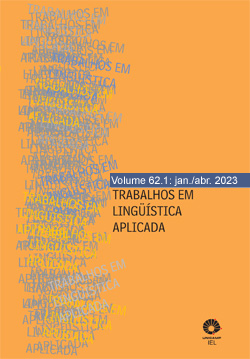Abstract
The COVID-19 global crisis has changed in many ways how educational activities happen, especially when the encounters migrated to video-mediated settings. In this paper, from a comparative perspective, we investigate online and in-person classes. We examine a recurring practice in pedagogical contexts: referencing objects – e.g. a task in a textbook, a document, or a non-digital object. We analyze how teachers and learners interactionally accomplish referencing. We describe the multimodal resources deployed and reflect on the affordances and challenges in each environment. Using Multimodal Conversation Analysis (SACKS, 1992; MONDADA, 2014), we conduct a fine-grained analysis of the unfolding of referencing practices in audio and video-recorded online and in-person classes. The analysis reveals that although many of the resources mobilized by teachers to refer to an object are common to both environments, they are accomplished through different means due to contingencies imposed by each environment. However, there are crucial differences that generate important repercussions. The in-person environment, for example, is characterized by being a context in which learners and their objects are visually accessible (i.e., independent from a camera that captures them), thus enabling their monitoring and, consequently, ensuring the full accomplishment of the referencing process, something which is not possible (yet) in the virtual environment. Furthermore, in online classes, when referencing an object, learners also need to deal with specific contingencies of the non-physical copresence, especially with those that demand synchrony of actions and visual access (both ways) to mobilize joint attention. Therefore, we show how these (and other) challenges imply interactional efforts by the participants to make the teaching and learning process possible.
References
BALAMAN, U.; PEKAREK DOEHLER, S. (2022). Navigating the complex social ecology of screen-based activity in video-mediated interaction. Pragmatics, v. 32, n. 1, p. 54-79. DOI: https://doi.org/10.1075/prag.20023.bal .
COLINA, V. (2021). Citizen Experience Design for Digital Transformation. Inter American Development Bank. Dispoível em: https://publications.iadb.org/publications/english/document/Citizen-Experience-Design-for-Digital-Transformation.pdf . Acesso em: 28 jul. 2022.
DE STEFANI, E. (2014). Establishing joint orientation towards commercial objects in a self-service store: how practices of categorisation matter. In: Nevile, M.; Haddington, P.; Heinemann, T.; Rauniomaa, M. (eds.), Interacting with objects: language, materiality, and social activity. Amsterdam: John Benjamins, p. 271-294. DOI: https://doi.org/10.1075/z.186.12ste .
GUICHON, N.; WIGHAM, C. R. (2016). A semiotic perspective on webconferencing supported language teaching. ReCALL, n. 28, v. 1, n. 28, p. 62-82.
IBGE - INSTITUTO BRASILEIRO DE GEOGRAFIA E ESTATÍSTICA. (2021). Síntese de indicadores sociais: uma análise das condições de vida da população brasileira 2021. Rio de Janeiro: IBGE 2021. Disponível em: <https://biblioteca.ibge.gov.br/visualizacao/livros/liv101892.pdf . Acesso em: 28 jul. 2022.
JAKONEN, T.; DOOLY, M.; BALAMAN, U. (2022). Interactional practices in technology-rich L2 environments in and beyond the physical borders of the classroom. Classroom Discourse, v. 13, n. 2, p. 111-118. DOI: https://doi.org/10.1080/19463014.2022.2063547 .
JEFFERSON, G. (2004). Glossary of transcript symbols with an introduction. In: Lerner, G. H. (ed.), Conversation analysis: Studies from the first generation. Amsterdam: John Benjemins, p. 13-31.
KIDWELL, M.; ZIMMERMAN, D. H. (2007). Joint attention as action. Journal of Pragmatics, v. 39, p. 592-611. DOI: https://doi.org/10.1016/j.pragma.2006.07.012 .
KONRAD, P. G.; OSTERMANN, A. C. (2020). “Tu sabe? Te lembra?”: o resguardo de informações em interrogatórios policiais por meio da (com)posição de perguntas e respostas. Linguagem em (Dis)curso – LemD, Tubarão, SC, v. 20, n. 1, p. 73-95. DOI: http://dx.doi.org/10.1590/1982-4017-200105-1119 .
MONDADA, L. (2014). The local constitution of multimodal resources for social interaction. Journal of Pragmatics, v. 65, p. 137-156. DOI: https://doi.org/10.1016/j.pragma.2014.04.004.
MONDADA, L. (2018). Multiple Temporalities of Language and Body in Interaction: Challenges for Transcribing Multimodality. Research on Language and Social Interaction, v. 1, n. 51, p. 85-106. DOI: https://doi.org/10.1080/08351813.2018.1413878.
MONDADA, L. (2019) Practices for showing, looking, and videorecording: the interactional establishment of a common focus of attention. In: Reber, E.; Gerhardt, C. (eds.), Embodied Activities in Face-to-Face and Mediated Settings: Social Encounters in Time and Space. Palgrave MacMillan, p. 63-106. DOI: 10.1007/978-3-319-97325-8_3.
MONDADA, L. (2019). Conventions for multimodal transcription. Disponível em: <https://www.lorenzamondada.net/multimodal-transcription>. Acesso em: 4 ago. 2022.
MONDADA, L. (2021) How early can embodied responses be? Issues in time and sequentiality. Discourse Processes, v. 58, n. 4, p. 397-418. DOI: https://doi.org/10.1080/0163853X.2020.1871561.
OHLWEILER, M. K. (2022). Pandemia COVID-19 e análise da conversa multimodal: porque o lar vira trabalho, mas o trabalho não vira um lar. Dissertação de Mestrado em Linguística Aplicada. Programa de Pós-Graduação em Linguística Aplicada, Unisinos, São Leopoldo.
OLBERTZ-SIITONEN, M.; PIIRAINEN-MARSH, A. (2021). Coordinating action in technology-supported shared tasks: Virtual pointing as a situated practice for mobilizing a response. Language & Communication, n. 79, p. 1-21. DOI: https://doi.org/10.1016/J.LANGCOM.2021.03.005 .
OSTERMANN, A. C.; FREZZA, M.; PEROBELLI, R. (2020). Literacy without borders: the fine-grained minutiae of social interaction that do matter (also in promoting health literacy). Trabalhos em Linguística Aplicada, v. 1, n. 59, p. 330-352. DOI: https://doi.org/10.1590/010318135866215912020.
SACKS, H. (1992). Lectures on Conversation. Oxford, UK: Blackwell.
SATAR, H. M. (2016) Meaning-making in online language learner interactions via desktop videoconferencing. ReCALL, v. 3, n. 28, p. 305-325. DOI: https://doi.org/10.1017/S0958344016000100.
SATAR, M.; WIGHAM, C. R. (2020). Delivering task instruction in multimodal synchronous online language teaching. ALSIC, v. 23, n. 1. DOI:10.4000/alsic.4571. Disponível em: <http://journals.openedition.org/alsic/4571>. Acesso em: 19 ago. 2022.
SCHEGLOFF, E. A. (2007). Sequence organization in interaction: A primer in conversation analysis. Cambridge: Cambridge University Press.

This work is licensed under a Creative Commons Attribution 4.0 International License.
Copyright (c) 2023 Trabalhos em Linguística Aplicada


